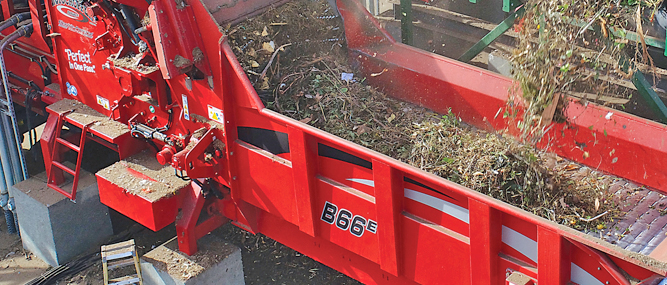
Wood Residuals Program: When a California biomass producer was required to switch from urban wood fiber to high-risk forestry waste, it purchased a high powered B66E electric grinder to help meet the challenge.
Finding end markets for residuals can be a challenge for wood pallet and packaging companies. For example, available outlets for fiber in California have shrunk in recent years due to the loss of biomass energy plants. Biomass plants have decreased in number from around 60 facilities to just 23. From a cost perspective, electricity from other sustainable sources such as solar is cheaper, and so as power company contracts have expired, more of them have become shuttered.
Despite cost structure, however, it is important to keep some biomass plants open. They play a critical role in maintaining forest health by providing an outlet for unwanted material – a more sustainable option than open burning or leaving deadwood in the forest where it serves as potential fuel for wildfires. For biomass plants that remain in service such as Rio Bravo Rocklin, the emphasis has shifted from urban to forest waste as government decision-makers look at biomass as an opportunity to help eliminate Cal Fire-designated High Fire Hazard Zone (HHZ) forestry residuals.
Simply put, biomass plants produce electricity by burning renewable plant-based waste, including forest, agricultural and urban wood residuals. The resulting heat generates high-pressure steam, which drives a steam turbine to produce electricity.
“The dynamic of this plant has changed drastically over the 30 years,” explained Scott Pedersen, fuel manager at Rio Bravo Rocklin. Originally, biomass plants were built with forest residuals in mind, located at the base of the Sierra Nevada mountain range and along the Central Valley.
Over the years, however, forest waste became increasingly more remote and harder to procure. “So, we shifted gears and started becoming an urban waste plant with a lot of the material coming out of the Bay Area,” he added.
When it came time to renew its contract in 2016, however, the Rocklin facility was tasked with changing its inbound composition to 80% HHZ forest residuals. With the change in feedstock from urban wood to forest residuals, the company looked to invest in onsite grinding capacity for the first time. “We decided to put in a grinder because we were hoping it would reduce the cost of getting forest biomass,” Pedersen explained. While the vast majority of material still arrives in chip form, the addition of the grinder provided the flexibility of also chipping incoming material at the plant.
Rio Bravo Rocklin decided to go with a new Rotochopper B66E, the most powerful electric model in the Rotochopper line. The choice of going electric versus diesel is increasingly common in California. Pedersen said the plant was instructed to go in that direction by the local county. From Pedersen’s perspective, there are pros and cons to the choice. The simplicity of the electric model offers superior uptime versus diesel alternatives along with the elimination of CO2 emissions. On the other hand, because of its power supply requirements, Pedersen does not have the flexibility to transport it to other locations to grind forest or agricultural waste.
Pedersen has enjoyed a very positive relationship with Rotochopper. “Whenever we need anything from them, they’re really helpful,” he said. When the biomass operation bought the machine, Rotochopper sent out a technician to help staff get up to speed with operations and maintenance.
An excavator with a shear attachment is used to load material into the Rotochopper. Longer lengths and bulkier stock are sheared and then mixed with green waste to provide a more uniform feedstock. By creating a more consistent blend, Rio Bravo Rocklin can avoid changeover time that would be required to swap out the teeth to accommodate bulky versus green waste material.
One interesting feature at the plant is the chip truck dumper. Rigs back into the hydraulically lifted dumper. A truck is suspended into the air at an eventual 75-degree angle and the biomass contents are unloaded by gravity into the surge storage pile beneath. Chipped material is conveyed, where it merges with fiber coming out of the Rotochopper before accumulating in the yard.
Aside from producing clean energy, the Rio Bravo Rocklin plant recovers nails and metal, which are recycled. The burning process also produces very fine ash that is utilized by the dairy farmers to dust over livestock waste and improve sanitary conditions.
Rio Bravo Rocklin has been helpful in address California’s forest waste management challenges. Its contract has been extended through 2027. Looking toward the future, forest fires seem certain to remain a serious threat in the years ahead, and biomass operations are poised to play a crucial role in mitigating that risk.
Originally posted in Pallet Enterprise July 2020 edition.
